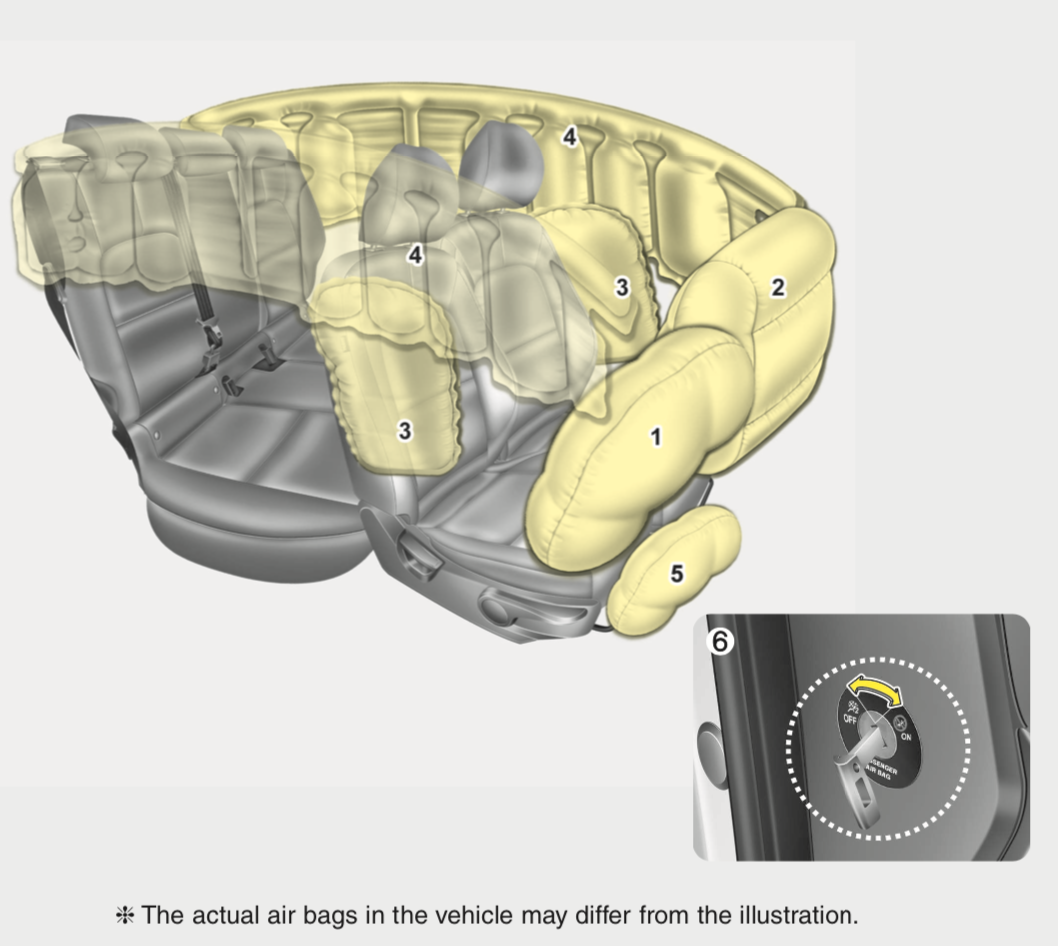Picanto airbag are fully equipped in Korea and Europe. In some other countries, usually only equipped with 2 airbags, even non-airbag

- Driver’s front air bag*
- Passenger’s front air bag*
- Side air bag*
- Curtain air bag*
- Driver`s knee air bag*
- Front passenger’s air bag ON/OFF switch*
* : if equipped
What are Airbags
An airbag is a vehicle occupant-restraint system using a bag designed to inflate extremely quickly, then quickly deflate during a collision. It consists of the airbag cushion, a flexible fabric bag, an inflation module, and an impact sensor. The purpose of the airbag is to provide a vehicle occupant a soft cushioning and restraint during a crash event. It can reduce injuries between the flailing occupant and the interior of the vehicle.
How does the air bag system operate
Air bags are activated (able to inflate if necessary) only when the ignition switch is turned to the ON or START position.
Air bags inflate instantly in the event of a serious frontal collision or side collision (if equipped with a side air bag or curtain air bag) in order to help protect the occupants from serious physical injury.
In normal conditions, the airbag is designed to deploy based on cer- tain angle and intensity of the collision. These two factors are crucial elements for deciding whether to transmit airbag deployment signal or start the electrical operation or not.
The airbag will deploy based on angle and intensity of the collision. It will not deploy in every crash or collision situations
The front air bags will completely inflate and deflate in an instant. It is virtually impossible for you to see the air bags inflate during an accident.
It is much more likely that you will simply see the deflated air bags hanging out of their storage compartments after the collision.
In order to help provide protection in a severe collision, the air bags must inflate rapidly. The speed of the air bag inflation is a consequence of extremely short time in which a collision occurs and the need to inflate the air bag between the occupant and the vehicle structures before the occupant impacts those structures.
However, air bag inflation can also cause injuries which can include facial abrasions, bruises and broken bones because the inflation speed also causes the air bags to expand with a great deal of force.
Noise and smoke
When the air bags inflate, they make a loud noise and they leave smoke and powder in the air inside of the vehicle. This is normal and is a result of the ignition of the air bag inflator. After the air bag inflates, you may feel substantial discomfort in breathing due to the contact of your chest with both the seat belt and the air bag, as well as from breathing the smoke and powder. Open your doors and/or windows as soon as possible after impact in order to reduce discomfort and prevent prolonged exposure to the smoke and powder.
Though the smoke and powder are non-toxic, they may cause irritation to the skin (eyes, nose and throat, etc). If this is the case, wash and rinse with cold water immediately and consult a doctor if the symptom persists.
Air bag warning light
The purpose of the air bag warning light in your instrument panel is to alert you of a potential problem with your air bag – Supplemental Restraint System (SRS).
When the ignition switch is turned ON, the warning light should illuminate for approximately 6 seconds, then go off.
Have the system checked if:
- The light does not turn on briefly when you turn the ignition ON.
- The light stays on after illuminating for approximately 6 seconds.
- The light comes on whilst the vehi- cle is in motion.
- The light blinks when the ignition switch is in ON position.
Driver’s and passenger’s front air bag (if equipped)
Your vehicle is equipped with a Supplemental Restraint (Air Bag) System and lap/shoulder belts at both the driver and passenger seating positions.
The indications of the system’s presence are the letters “AIRBAG” engraved on the air bag pad cover in the steering wheel and the passenger’s side front panel pad above the glove box.
Side air bag (if equipped)
Your vehicle is equipped with a side air bag in each front seat. The purpose of the air bag is to provide the vehicle’s driver and the front passenger with additional protection than that offered by the seat belt alone.
The side air bags are designed to deploy only during certain sideimpact collisions, depending on the crash severity, angle, speed and point of impact. The side air bags are not designed to deploy in all side impact situations.
Curtain air bag (if equipped)
Curtain air bags are located along both sides of the roof rails above the centre pillar. They are designed to help protect the heads of the front seat occupants and the rear outboard seat occupants in certain side impact collisions.
The curtain air bags are designed to deploy only during certain side impact collisions, depending on the crash severity, angle, speed and impact. The curtain air bags are not designed to deploy in all side impact situations, collisions from the front or rear of the vehicle or in most rollover situations.
Search on Google
- does kia picanto have airbags
- how many airbag in kia picanto
- airbag system picanto